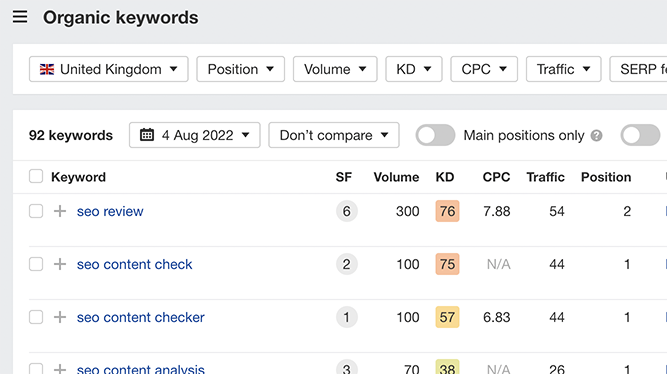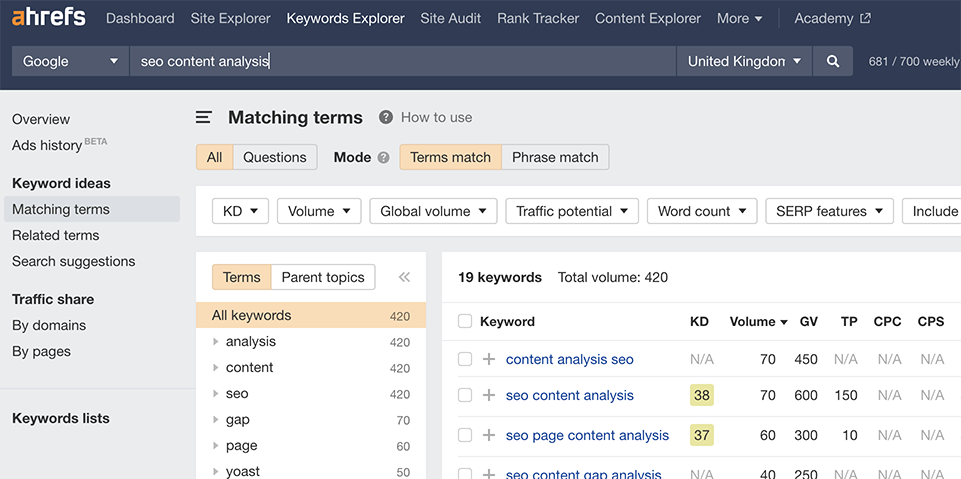
Optimising blog content for SEO purposes is an essential skill for anyone looking to use search engines to grow their business.
With this in mind, it’s quite surprising just how many business owners don’t know how to write creative blog posts that successfully boost their business’ search engine visibility.
There’s much more to writing blog posts for SEO than just peppering keywords throughout an article on any topic.
In order to rank higher in the search engine results pages (SERPs), you need to write great content that is both informative and interesting to readers.
While there are many different ways to do this, one of the best methods is through creative and informative SEO blog writing which answers the common questions and queries your audience has.
By writing about topics that are relevant to your audience, identifying the right keywords and inserting keywords effectively, you can help your website move up in the search engine rankings.
So, what is SEO blog writing and how do you do it successfully? Read on for our advice for creating top-quality blog content that will rank positively with Google.
What is SEO blog writing?
Put simply, SEO (search engine optimisation) blog writing is the practice of creating long-form content for your businesses website with the aim of ranking in Google’s search results for a relevant phrase.
If this can be done in an effective way, you may see your organic site traffic boosted exponentially.
Is blog writing good for SEO?
Blog posts are great for boosting SEO because, providing you’ve done your keyword research correctly, they are typically rich in relevant keywords and phrases.
A well-written and informative blog post with a topic relevant to your specific business not only allows you to link back to other pages on your site – product category pages, service pages, etc. – but also improves your site’s authority with Google.
Authority is a measure used by Google’s algorithm when positioning new pages within the search results. Your level of authority reflects how much the search engine ‘trusts’ you as an expert on a particular topic.
The more relevant and SEO optimised content appears on your site, the higher your level of authority in your area of expertise according to Google.
Overall, blog writing for SEO can be a brilliantly effective way to climb the search engine rankings and drive more organic traffic to your site – that is, of course, if you know how to do it correctly.
How to write blogs for SEO
The process of creating successful SEO blog content is one with several steps, each of which is important to carry out correctly. Your blog strategy should always begin with keyword research, before you move onto creating a brief structure and then writing your blog.
Finally, take steps to ensure that your blog is optimised for search engines before uploading.
SEO keyword research
Google generates millions – sometimes even billions – of results for individual search engine results pages (SERPs) for search terms, so you’ll need to identify quality target keywords in order to get your blog post on page one.
It’s important to target the specific keywords and phrases that your target audience is searching for if you want to outrank your competition and cut through SERPs clutter.
Otherwise, how else will your audience locate your content and website?
To begin your research, use a keyword research tool to identify some long and short tail keywords that are relevant to your chosen topic. For this demonstration, we’ll use Ahrefs, one of the keyword research tools we use here at Custard.
There are two main methods for identifying keywords in Ahrefs. The first step is to simply enter your blog title into Google and open the top three results, ensuring you select the top organic results and not paid ads. These results may contain your main competitors’ blogs.

Copy each link into Ahrefs’ site explorer function, setting your search to ‘exact URL only’. You’ll then be able to identify the top organic keywords that your competitor blogs rank for, these being the words that are most beneficial to include in your own piece.

You could also simply enter the topic of your blog post into the keyword explorer and note down the relevant keywords returned by this.

Keep in mind to not only pay attention to the keywords with the very highest search volume – it can be far more difficult to rank for a keyword with a search volume of 1.5k than one with a volume of 500. Using a pool of keywords with both high and lower search volume is generally best practice.
Once you have your keywords, it’s time to structure your blog.
Create a blog post structure
When it comes to writing blog posts for SEO, simply writing thousands of words of content and hoping for the best won’t do. To give your post the best chance at being informative, entertaining and ranking effectively, you should outline your post structure.
As a general rule of thumb, SEO blog posts are always best structured in the following way:
- Your blog’s intro should provide a quick overview of the topic and the individual points you will cover. Avoid ‘waffling’ too much during your introduction – it’s always best to get straight to the point.
- Relevant sub-headings. The ‘meat’ of your content should be broken down into several short paragraphs, each titled using a relevant sub-heading. Ideally, you should look at your keywords and identify any that may make relevant sub-headings. For example, in this very post we’ve used the target keyphrase ‘SEO keyword research’ as a sub-heading.
- Conclusion & CTA. Your conclusion, like your introduction, should be straight to the point. Summarise the point that you’d like your audience to take away from the post and finish with a short call-to-action for your business. Your CTA should be no longer than a couple of sentences and should direct your audience to the next steps you’d like them to take, with any relevant links included – for example, ‘browse the range here’, ‘contact us here for more information’, etc.
At this stage, you should also decide on a target word count for your finished blog. When deciding this, take into account the length of your competitor blogs – you should ideally aim to make your finished around the same length.
Writing your blog post
Now you’ve identified your structure, it’s time to start writing.
If you’re happy enough to write each paragraph in full, write away. Otherwise, you might benefit from outlining each paragraph with short bullet points and filling them out from there.
Keep in mind the tone and style of the writing – this should fall in line with the tone your audience would expect from your business. For example, a business consultancy firm might use a formal voice, demonstrating professionalism and expertise, while a store selling pet care products might prefer to take a friendlier and more approachable tone.
Once you are happy with the finished post, be sure to read it over a few times and run a spell-check to catch out any typos and formatting errors, as well as to ensure that there’s no important information you’ve forgotten to add.
How to optimise blogs for SEO
Once you’ve written your blog in full, it’s time to make sure that it is optimised properly in order to give it the best chance of ranking highly.
There are a few different steps to ensuring that your blog is thoroughly optimised for SEO.
Adding keywords
Cross-reference your finished blog with the list of relevant keywords that you identified at the beginning of the process. Have you been able to add each one in?
Ensuring you’ve adding enough relevant keywords and phrases is crucial in securing a good ranking for your post once it goes live. If there are some you’ve missed, be sure to go back through your post and search for the most logical place to include them.
You should aim to include your most prominent target keywords multiple times, without ‘keyword stuffing’, something you could find yourself penalised for if you appear to be placing keywords awkwardly and abundantly into a piece.
Optimising meta data
You’ll likely already know about the importance of optimising your meta data, specifically the meta title and description of your blog.
Your meta title and description is the first thing an internet user sees when your blog appears in a Google search, so it’s imperative that your meta data persuades the user to read on.
While Google does not take your meta description into account directly when ranking pages, the quality of your meta data could have a potentially huge impact on your click-through rate (CTR). The lower your CTR, the lower your page is likely to rank in the search results.
As a general rule, your meta title should include the title of your blog post and the name of your business, while the description should give very short but clear summary of the blog’s content. Ideally, these should be 60 and 150 characters long respectively.

If you make your meta data too long, it will be cut short and will not appear in full within Google’s search results. This could stop you from relaying the message you want to send to search engine users, leading to a drop in your CTR.

Are longer blogs better for SEO?
Google’s ranking algorithm takes the authority of your site into account when ranking pages, authority being determined by the quality of the information on your site.
A blog post of around 100 words is unlikely to provide anywhere near enough substantial information on your topic for it to be considered a reliable source, however, the word count of your blogs should vary and look to only be as long as required to answer the topic.
You could damage your authority just as much by attempting to write thousands of words on a topic that could be covered thoroughly in half as many.
When deciding on a target word count, you should work on a case-by-case basis, taking into account the length of the most successful blogs with the same target keyword.
Custard SEO
Creating compelling, informative and high-ranking content is crucial to the success of your business website but it’s a time-consuming process.
At Custard, we pride ourselves on delivering proven digital marketing strategies to clients across a wide range of industries – SEO blog content is just one of our many specialities.
If you’d like more information about outsourcing your business’ SEO content writing to our experienced content team or to enquire about our PPC and SMM services, don’t hesitate to get in touch today.





